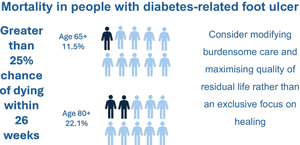Diabetologia ( IF 8.4 ) Pub Date : 2024-09-27 , DOI: 10.1007/s00125-024-06262-w Naomi Holman, Arthur C. Yelland, Bob Young, Jonathan Valabhji, William Jeffcoate, Fran Game

|
Aims/hypothesis
People with diabetes-related foot ulcers (DFUs) have high mortality rates. This analysis assesses the impact of selected risk factors on short-term mortality using a population registered in the National Diabetes Foot Care Audit (NDFA).
Methods
Mortality rates at 12, 26 and 52 weeks was assessed in people with a new DFU registered by a specialist diabetes footcare service in the NDFA in England and Wales between April 2017 and March 2022. Poisson regression models were created to explore risk factors for mortality.
Results
In 71,000 people registered with a new DFU, mortality rates at 12, 26 and 52 weeks was 4.2%, 8.2% and 14.4%, respectively. At 26 weeks, higher mortality rates was associated with older age (rate ratio 2.15; 95% CI 2.03, 2.28, for age ≥80 years vs age 65–79 years), certain ulcer characteristics (area ≥1 cm2 [1.50; 95% CI 1.42, 1.59], deep ulcers [1.26; 95% CI 1.18, 1.35] or hindfoot location [1.53; 95% CI 1.44, 1.62]) and recorded evidence of ischaemia in the lower limb (1.78; 95% CI 1.69, 1.88) and various comorbidities (heart failure [2.13; 95% CI 2.00, 2.26], myocardial infarction [1.45; 95% CI 1.29, 1.63], stroke [1.37; 95% CI 1.22, 1.53], renal replacement therapy [2.34; 95% CI 2.09, 2.61] and chronic kidney disease stage 3 or greater [1.20; 95% CI 1.12, 1.29]). The 26-week mortality rate exceeded 25% for 7.3% of all individuals, rising to 11.5% of those aged 65 years and older, and 22.1% of those aged 80 years and over.
Conclusions/interpretation
Short-term mortality rates in people with a DFU is high. Teams managing people with DFUs should consider modifying the burdensome interventions and care required to heal such ulcers so maximising the quality of residual life, rather than focusing exclusively on healing.
Graphical Abstract
中文翻译:

患有新的糖尿病相关足部溃疡的患者的死亡率:一项对治疗有影响的队列研究
目标/假设
患有糖尿病相关足部溃疡 (DFU) 的人死亡率很高。该分析使用国家糖尿病足部护理审计 (NDFA) 中登记的人群来评估选定风险因素对短期死亡率的影响。
方法
2017 年 4 月至 2022 年 3 月期间,英格兰和威尔士 NDFA 的专业糖尿病足部护理服务机构对新发 DFU 患者在 12、26 和 52 周时的死亡率进行了评估。创建泊松回归模型是为了探索死亡率的危险因素。
结果
在 71,000 名新发 DFU 患者中,12、26 和 52 周时的死亡率分别为 4.2%、8.2% 和 14.4%。 26周时,较高的死亡率与年龄较大(年龄≥80岁与65-79岁相比,比率为2.15;95% CI 2.03,2.28)、某些溃疡特征(面积≥1 cm 2 [1.50;95] % CI 1.42, 1.59]、深度溃疡 [1.26;95% CI 1.18, 1.35] 或后足位置 [1.53;95% CI 1.44, 1.62])以及记录的下肢缺血证据(1.78;95% CI 1.69, 1.88)和各种合并症(心力衰竭 [2.13; 95% CI 2.00, 2.26]、心肌梗死 [1.45; 95% CI 1.29, 1.63]、中风 [1.37; 95% CI 1.22, 1.53]、肾脏替代治疗 [2.34; 95% CI 1.22, 1.53]。 95% CI 2.09, 2.61] 和慢性肾病 3 期或以上 [1.20;95% CI 1.12, 1.29])。 7.3%的人群26周死亡率超过25%,65岁及以上人群的26周死亡率上升至11.5%,80岁及以上人群的22.1%。
结论/解释
DFU 患者的短期死亡率很高。管理 DFU 患者的团队应考虑修改治愈此类溃疡所需的繁重干预措施和护理,从而最大限度地提高剩余生活质量,而不是仅仅专注于治愈。


















































 京公网安备 11010802027423号
京公网安备 11010802027423号